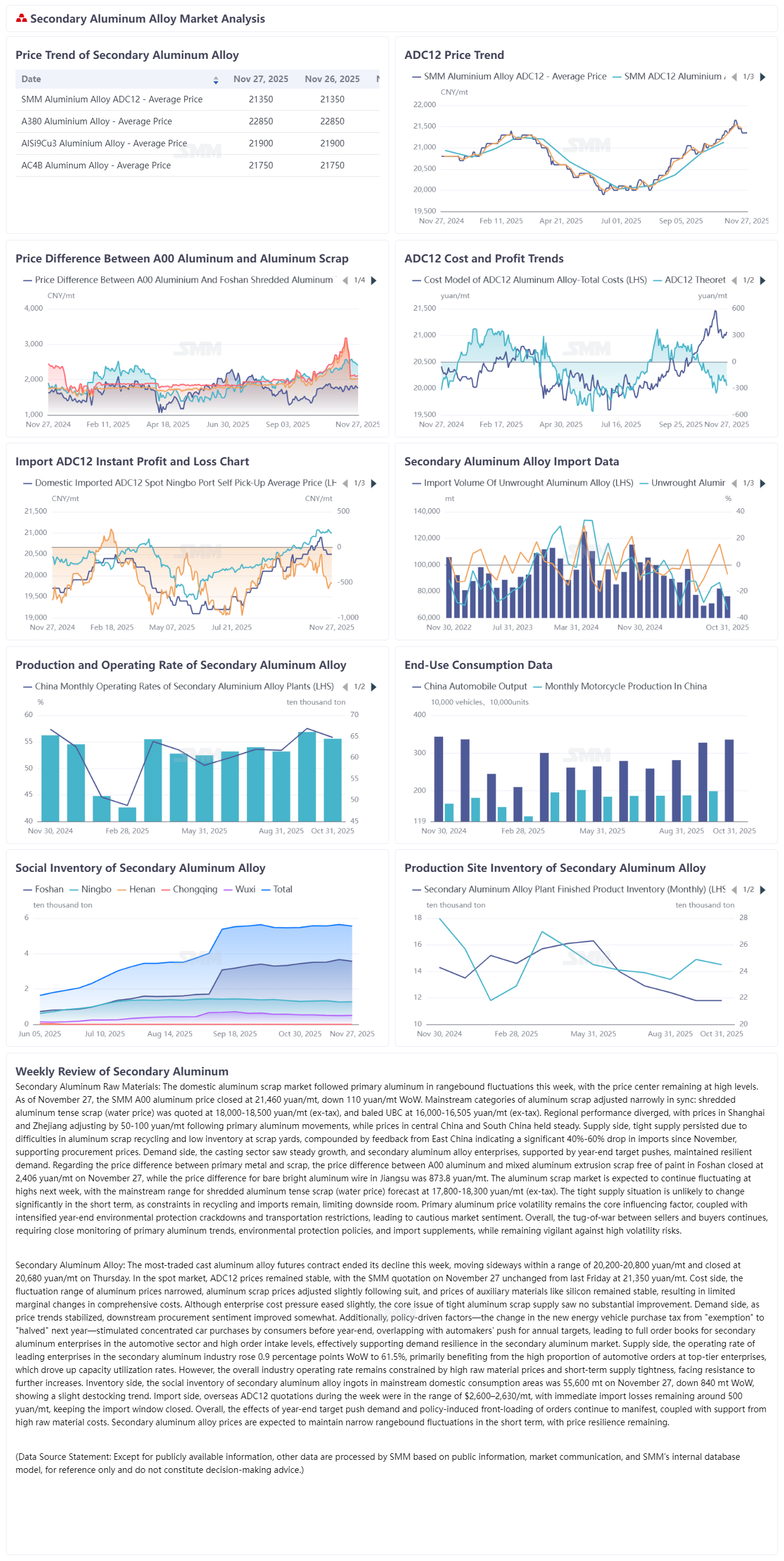






Domestic aluminum scrap market followed primary aluminum fluctuations this week, with the price center remaining high. As of November 27, the SMM A00 aluminum price closed at 21,460 yuan/mt, down 110 yuan/mt WoW. Mainstream aluminum scrap categories adjusted narrowly in sync: shredded aluminum tense scrap (water price) was quoted at 18,000–18,500 yuan/mt (ex-tax), and baled UBC at 16,000–16,505 yuan/mt (ex-tax). Regional performance diverged, with prices in Shanghai and Zhejiang adjusting by 50–100 yuan/mt following primary aluminum movements, while central China and southern China prices held steady. Supply side remained tight, with difficult aluminum scrap recycling and low inventory at scrap yards, compounded by feedback from east China indicating a 40%–60% sharp drop in imports since November, supporting procurement prices. Demand side saw steady growth in the casting sector, and secondary aluminum alloy enterprises maintained resilient demand supported by the push for annual targets at year-end. Regarding the price difference between primary metal and scrap, the price difference between A00 aluminum and mixed aluminum extrusion scrap free of paint in Foshan closed at 2,406 yuan/mt on November 27, while the price difference between A00 aluminum and bare bright aluminum wire in Jiangsu was 873.8 yuan/mt. The aluminum scrap market is expected to continue fluctuating at highs next week, with shredded aluminum tense scrap (water price) projected in the mainstream range of 17,800–18,300 yuan/mt (ex-tax). The tight supply situation is unlikely to change significantly in the short term, as constraints in recycling and imports persist, limiting downside room. Primary aluminum price volatility remains the core influencing factor, coupled with intensified year-end environmental protection crackdowns and transportation restrictions, leading to cautious market sentiment. Overall, the tug-of-war between sellers and buyers continues, requiring close monitoring of primary aluminum trends, environmental protection policies, and import replenishment, while staying alert to high volatility risks.
This week, the most-traded cast aluminum alloy futures contract ended its decline and moved sideways within the range of 20,200–20,800 yuan/mt, closing at 20,680 yuan/mt on Thursday. On the spot side, ADC12 prices remained stable, with the SMM quotation on November 27 flat WoW at 21,350 yuan/mt. Cost side, aluminum price fluctuations narrowed, aluminum scrap prices followed with minor adjustments, while prices of auxiliary materials such as silicon remained steady, resulting in limited marginal changes in overall costs. Although cost pressure on enterprises eased slightly, the core issue of tight aluminum scrap supply saw no substantial improvement. Demand side, as prices stabilized, downstream purchasing sentiment improved. Additionally, policy-driven factors—the new energy vehicle purchase tax will shift from "exemption" to "50% reduction" next year—stimulated concentrated car purchases before year-end. Coupled with automakers’ push for annual targets at year-end, secondary aluminum enterprises saw robust orders in the automotive sector, with order intake remaining high, effectively supporting demand resilience in the secondary aluminum market. Supply side, the operating rate of leading enterprises in the secondary aluminum industry rose 0.9 percentage points WoW to 61.5%, mainly driven by the high proportion of automotive orders at top-tier enterprises, which boosted capacity utilization rates. However, the overall industry operating rate remained constrained by high raw material prices and short-term supply tightness, limiting further upside potential. Inventory side, social inventory of secondary aluminum alloy ingots in mainstream consumption areas stood at 55,600 mt on November 27, down 840 mt from the previous Thursday, indicating a slight destocking trend. Import side, overseas ADC12 quotations ranged between $2,600–2,630/mt during the week, with immediate import losses remaining around 500 yuan/mt, keeping the import window closed. Overall, the effects of year-end target pushes and policy-induced front-loading of orders continue to emerge. Combined with support from high raw material costs, secondary aluminum alloy prices are expected to maintain narrow fluctuations in the short term, with price resilience remaining intact.

For queries, please contact Lemon Zhao at lemonzhao@smm.cn
For more information on how to access our research reports, please email service.en@smm.cn
